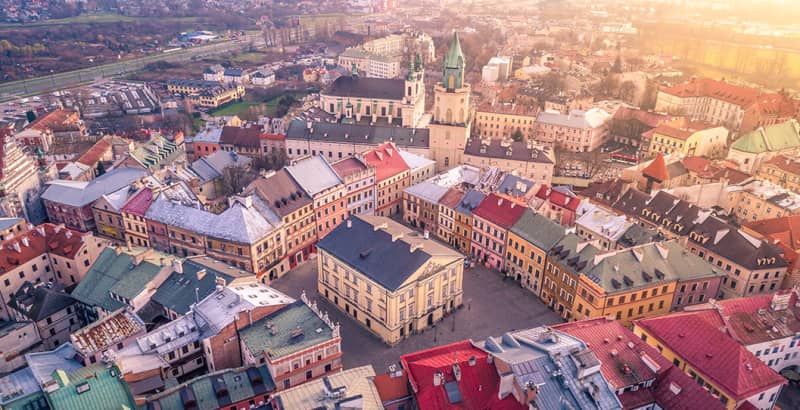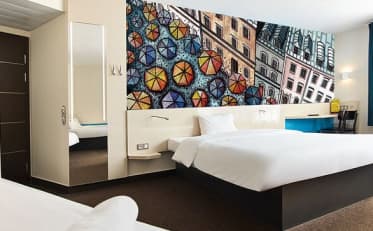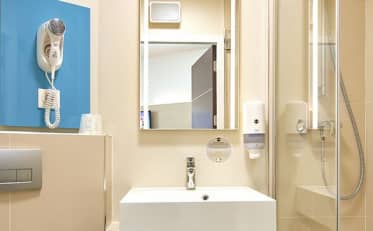Lublin, 1 hotel

Our hotel in Lublin
It's worth visiting Lublin
It's worth coming to Lublin to discover its unique atmosphere. The beautiful Old Town, charming streets, monuments bearing witness to the city's turbulent history and regional delicacies are just some of the reasons for visiting Lublin. There are picturesque walking routes through the Old Town, restaurants, cafés and galleries. Lublin is also a university centre, a place vibrant with life and incredible energy.
A city unique in its own way
Situated in the Lublin Upland on the Bystrzyca River, only 170 km from Warsaw, and about 100 km from the border crossing with Ukraine, Lublin is the ninth most populous city in Poland.
The long and turbulent history of the city dates back to the 6th century. For years, the settlement and later the town was an important administrative, trade and cultural centre. The city gained particular importance at the end of the 19th century, only to fall victim to the wars sweeping through this part of Europe in the 20th century.
Today's Lublin is a city full of inspiration, life and colour, proudly presenting the influences of the cultures that created it, a centre of science, culture, tourism, sport and recreation. A stroll through Lublin's Old Town is sure to be extremely interesting. Renovated tenement houses stand proudly next to those less well-kept, and the narrow streets, murals and unique colours of the local buildings please the eye of tourists. At noon, you can hear the bugle call resounding from the balcony of the town hall.
Comfortable accommodation in Lublin
To take benefit of Lublin's greatest attractions, it is worth choosing a hotel right in the Old Town. The B&B Lublin Centrum Hotel is located at 7 Dolna 3 Maja Street, from where you can start exploring Lublin in any way you like - on foot, by public transport, by taxi or by your own transport.
Worth seeing:
Old Town and Castle
The Old Town is full of historical monuments, including the remains of the city walls (the Krakowska and Grodzka Gates and the Gothic Tower), the Renaissance tenement houses, the former town hall (the Crown Tribunal) standing in the middle of the market square, the Archcathedral and the Trinity Tower, the Dominican Basilica, and the Old Theatre. Inside the city walls, the Plac po Farze (remnants of the parish church square), and in front of the Krakowska Gate, Plac Łokietka (King Łokietek square) are worth visiting.
Lublin's old town houses are very impressive - some of them are colourful and beautifully renovated, others are waiting to be restored to their former glory, but they all look intriguing.
Outside the city walls, there is the Castle with the Castle Chapel. Originally built in the 12th century and rebuilt many times, used as a prison from 1831 to 1954, since 1957, the Royal Castle of Lublin is the seat of the National Museum in Lublin.
Krakowskie Przedmieście (the Krakow Suburb)
This used to be a road leading from Lublin to Krakow. Today, it is a lively pedestrian zone, a place of local fairs and meeting place of the city residents. It's worth visiting, having a coffee and tasting local delicacies.
Brama Krakowska (the Krakow Gate) and the Museum of History of the City of Lublin
Lublin's Brama Krakowska is a 14th century gate guarding access to the Old Town in Lublin, a true landmark of the city. It is a remnant of the 14th century defensive walls; originally it was built in the Gothic style, and in the 18th century it was given a Baroque appearance.
The Trinity Tower
The Neo-Gothic bell tower is the highest monumental high point of Lublin. It is from here that the best view of the city panorama can be enjoyed. The Trinity Tower in Lublin, also called the Trinity Gate, was part of the buildings of the Jesuit College and at first it was just a monastery gate
On the trail of Lublin's Jews
Since the Middle Ages, Jews have been an important part of Lublin's community. In the 16th century, they founded here the Talmudic Academy, a Hebrew printing house. Over the years, the Jewish community in Lublin became one of the most numerous and prosperous in the Polish-Lithuanian Commonwealth, contributing significantly to the economic development of the city. Lublin was also an important centre of Hasidism, a mystical branch of Judaism. The famous Hasidic rabbi, Jacob Isaac Horowitz, also known as the Seer of Lublin, lived and was buried in the city. His grave in the old Jewish cemetery is still a place of pilgrimage for Hasidic Jews from all over the world.
State Museum at Majdanek
Witnessing the atrocities of the Second World War, the martyrological museum on the grounds of the former Nazi Concentration Camp KL Lublin was established in 1944. The State Museum at Majdanek is Europe’s oldest museum institution commemorating the victims of the Second World War. There are about 70 historical objects on the grounds of the Museum. Among them, the places directly connected with the mass extermination of people are of particular importance: gas chambers, crematorium, and execution ditches where about 18,000 Jews were shot. The Museum's mission is to nurture memory and develop historical education.
The Open Air Lublin Village Museum
Located in the valley of the Czechówka river, about 5 km from the city centre, the Lublin Village Museum (Muzeum Wsi Lubelskiej) is one of Poland’s largest open-air museums. It presents the cultural, landscape and ethnographic diversity of the Lublin region.
A visit to the museum, which is an opportunity to see memorabilia related to the former life of villages, manors and towns, also enables you to learn about everyday work, customs and traditions of people from a bygone era.
Outside the city is also interesting!
A visit to Lublin is certainly a good start to get to know the whole region; it is also worth going outside the city to see the charming towns of Nałęczów Zdrój and Kazimierz Dolny, the historical city of Zamość and the geographical region of Roztocze. The Lublin region has a varied landscape boasting loess ravines, nature reserves and beautiful forests. A sightseeing of the Roztocze National Park is certainly a great idea for a family trip out of town.




























